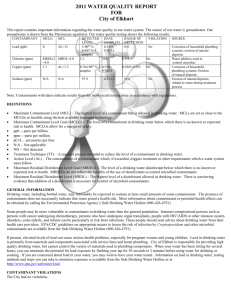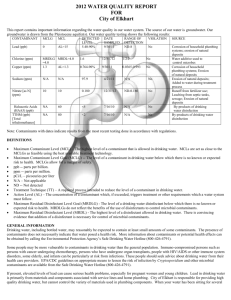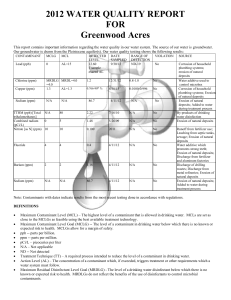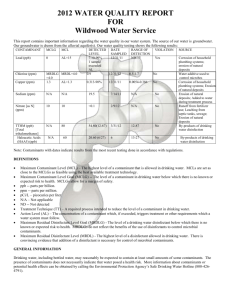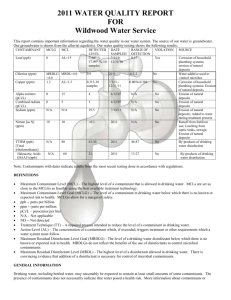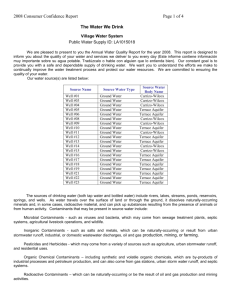contact information
advertisement
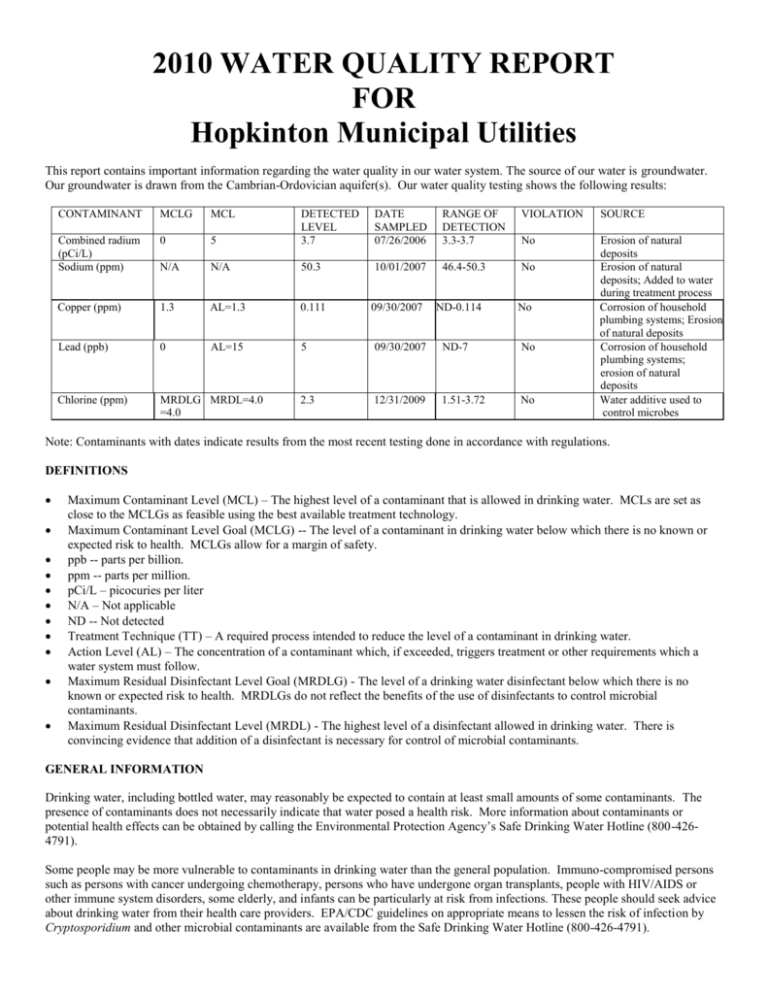
2010 WATER QUALITY REPORT FOR Hopkinton Municipal Utilities This report contains important information regarding the water quality in our water system. The source of our water is groundwater. Our groundwater is drawn from the Cambrian-Ordovician aquifer(s). Our water quality testing shows the following results: CONTAMINANT MCLG MCL DATE SAMPLED 07/26/2006 RANGE OF DETECTION 3.3-3.7 VIOLATION SOURCE 5 DETECTED LEVEL 3.7 Combined radium (pCi/L) Sodium (ppm) 0 No N/A N/A 50.3 10/01/2007 46.4-50.3 No Copper (ppm) 1.3 AL=1.3 0.111 Lead (ppb) 0 AL=15 5 09/30/2007 ND-7 No Chlorine (ppm) MRDLG MRDL=4.0 =4.0 2.3 12/31/2009 1.51-3.72 No Erosion of natural deposits Erosion of natural deposits; Added to water during treatment process Corrosion of household plumbing systems; Erosion of natural deposits Corrosion of household plumbing systems; erosion of natural deposits Water additive used to control microbes 09/30/2007 ND-0.114 No Note: Contaminants with dates indicate results from the most recent testing done in accordance with regulations. DEFINITIONS Maximum Contaminant Level (MCL) – The highest level of a contaminant that is allowed in drinking water. MCLs are set as close to the MCLGs as feasible using the best available treatment technology. Maximum Contaminant Level Goal (MCLG) -- The level of a contaminant in drinking water below which there is no known or expected risk to health. MCLGs allow for a margin of safety. ppb -- parts per billion. ppm -- parts per million. pCi/L – picocuries per liter N/A – Not applicable ND -- Not detected Treatment Technique (TT) – A required process intended to reduce the level of a contaminant in drinking water. Action Level (AL) – The concentration of a contaminant which, if exceeded, triggers treatment or other requirements which a water system must follow. Maximum Residual Disinfectant Level Goal (MRDLG) - The level of a drinking water disinfectant below which there is no known or expected risk to health. MRDLGs do not reflect the benefits of the use of disinfectants to control microbial contaminants. Maximum Residual Disinfectant Level (MRDL) - The highest level of a disinfectant allowed in drinking water. There is convincing evidence that addition of a disinfectant is necessary for control of microbial contaminants. GENERAL INFORMATION Drinking water, including bottled water, may reasonably be expected to contain at least small amounts of some contaminants. The presence of contaminants does not necessarily indicate that water posed a health risk. More information about contaminants or potential health effects can be obtained by calling the Environmental Protection Agency’s Safe Drinking Water Hotline (800-4264791). Some people may be more vulnerable to contaminants in drinking water than the general population. Immuno-compromised persons such as persons with cancer undergoing chemotherapy, persons who have undergone organ transplants, people with HIV/AIDS or other immune system disorders, some elderly, and infants can be particularly at risk from infections. These people should seek advice about drinking water from their health care providers. EPA/CDC guidelines on appropriate means to lessen the risk of infection by Cryptosporidium and other microbial contaminants are available from the Safe Drinking Water Hotline (800-426-4791). If present, elevated levels of lead can cause serious health problems, especially for pregnant women and young children. Lead in drinking water is primarily from materials and components associated with service lines and home plumbing. Hopkinton Municipal Utilities is responsible for providing high quality drinking water, but cannot control the variety of materials used in plumbing components. When your water has been sitting for several hours, you can minimize the potential for lead exposure by flushing your tap for 30 seconds to 2 minutes before using water for drinking or cooking. If you are concerned about lead in your water, you may wish to have your water tested. Information on lead in drinking water, testing methods, and steps you can take to minimize exposure is available from the Safe Drinking Water Hotline or at http://www.epa.gov/safewater/lead. CONTAMINANT VIOLATIONS None ADDITIONAL HEALTH INFORMATION None OTHER VIOLATIONS In September 2009, we failed to test the appropriate number of samples to monitor for Gross Alpha and Combined Radium. Adverse health effects, if any, are not known. Monitoring procedures have been corrected to avoid future violations. We, the Hopkinton Municipal public water supply, are required to monitor your drinking water for specific contaminants on a regular basis. Results of regular monitoring are an indicator of whether or not our drinking water meets health standards. During September 2009 we did test 1 sample but did not monitor or test the required 2 samples for Combined Radium and Gross Alpha and therefore cannot be sure of the quality of our drinking water during that time. SOURCE WATER ASSESSMENT INFORMATION The Hopkinton Municipal Utilities water supply obtains its water from the Cambrian –Ordovician aquifer. The Cambrian- Ordovician aquifer was determined to have insignificant susceptibility to contamination. Every Aquifer has a degree of susceptibility to contamination because of the characteristics of the aquifer, overlying materials and human activity. Susceptibility to contamination generally increased with shallower aquifers, increasing permeability of the aquifer and the overlying material, nearby development or agricultural activity, and abandoned or poorly maintained wells. A detailed evaluation of your source water was completed by the IDNR, and is available from Hopkinton Municipal Utilities at 563-926-2480. OTHER INFORMATION None CONTACT INFORMATION For questions regarding this information, please contact Douglas J Melchert at 563-926-2480, by fax at 563-926-2065 or by e-mail at hopmuni@n-connect.net during the following hours: 8 am-Noon; 1-4:30 pm. Decisions regarding the water system are made at the board meetings held on the 2nd Tuesday of each month at 5:00 p.m. in the city meeting room and are open to the public.
